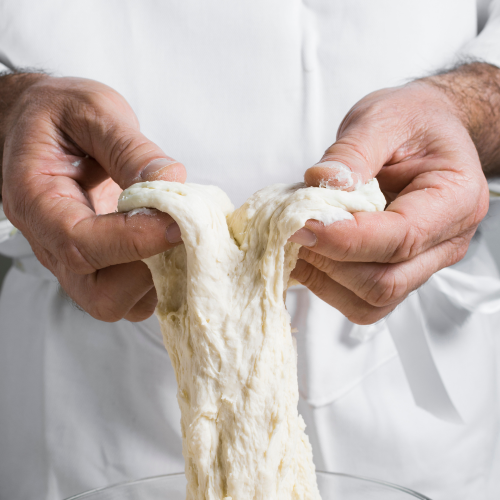Preparation Steps:
Autolysis:
In a large mixing bowl, combine the flour and 300 grams of the cold water. Mix until just incorporated.
Cover the bowl with a damp cloth and let it rest for 1 hour. This rest period allows the flour to fully hydrate and gluten to develop, resulting in a more extensible dough.
Mixing:
After the autolysis, dissolve the active dry yeast in the remaining 50 grams of cold water.
Add the yeast mixture, salt, and olive oil to the dough. Mix thoroughly until all ingredients are well incorporated.
Kneading:
Transfer the dough to a lightly floured surface. Knead for about 10 minutes until the dough is smooth and elastic.
Alternatively, you can use a stand mixer with a dough hook attachment on low speed for approximately 5 minutes, then increase to medium speed for an additional 5 minutes.
First Rise (Fermentation):
Place the dough in a lightly oiled bowl, cover it with a damp cloth or plastic wrap, and let it rise at room temperature (around 20°C or 68°F) for 1 hour, or until it has doubled in size.
Shaping:
Gently deflate the dough and divide it into two equal portions.
Shape each portion into a tight ball by folding the edges into the center and rolling it between your hands.
Place the dough balls on a floured surface, cover them, and let them rest for 30 minutes.
Stretching and Baking:
Preheat your oven to 250°C (482°F). If using a pizza stone or steel, place it in the oven during preheating.
On a floured surface, gently stretch one dough ball into a rectangular shape, approximately 35x40 cm (14x16 inches).
Transfer the stretched dough onto a piece of parchment paper or a floured pizza peel.
Add your desired toppings.
Bake for 10-12 minutes, or until the crust is golden brown and the toppings are cooked.
Variations and Tips:
Flour Selection: Using a strong bread flour with a high protein content will help develop the gluten structure necessary for a chewy crust.
Hydration: The dough's high hydration (70%) contributes to its airy texture. If the dough feels too sticky, you can adjust by adding a small amount of flour during kneading.
Fermentation: For enhanced flavor, you can perform a cold fermentation by placing the dough in the refrigerator for 24-48 hours after the first rise. Allow it to come to room temperature before shaping.
Toppings: Traditional toppings include fresh tomatoes, mozzarella, basil, and prosciutto. Feel free to experiment with other ingredients like arugula, mushrooms, or olives.
Dietary Substitutions:
Gluten-Free: Substitute the bread flour with a gluten-free all-purpose flour blend. Ensure the blend includes xanthan gum or add it separately to help with dough structure.
Vegan: Omit the olive oil or replace it with a plant-based oil. Use vegan cheese alternatives if desired.
